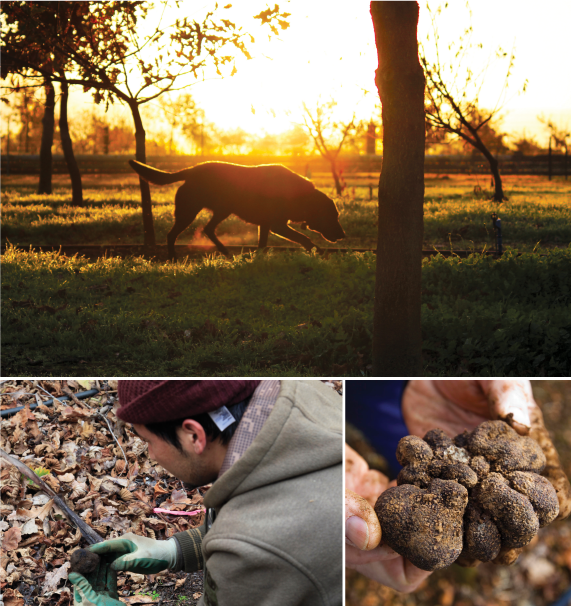Truffles to Market
Harversting the Truffle. Cleaning & Packing for Local & Export Markets

Harvesting the Truffles
Daylight hours are short in winter, so harvesting begins at dawn. There’s no need to wake the dogs — like children promised an outing, they’re keen and ready for the day to start. The work is in teams of three: a dog, a handler, and a harvester who follows with trowel at the ready.
Working systematically, the team walks up and down each row. A gentle breeze is what the handler hopes for, as this will bring the scent of truffle to the dog. On a still day, the dog has to work harder to find the scent; in a strong wind, the scent is dispersed too widely to identify the source.
Once the dog detects a truffle, it indicates the spot, then sits patiently while the handler marks the ground with a tag. This shows the harvester where to dig. They carefully expose the truffle before lifting it gently into the collection bag, as an undamaged truffle fetches a higher price than a broken or damaged specimen.
Truffles are a fresh product, and the whole harvesting and sorting process is designed to get the truffles to market as quickly as possible. The truffles are carefully washed and dried, then weighed and graded according to size and quality. The very best truffles are graded “extra class” — this is a perfect round truffle weighing over 30 grams, while smaller cut truffles and trimmings are still of value in the hands of a skilled chef.
Cleaning & Packing for Local & Export Markets
Like a piece of delicate porcelain, each truffle is individually wrapped before being gently placed in an insulated container, ready for the daily delivery to city restaurants or the airport. Oak Valley truffles travel the world — today it could be a large consignment destined for the markets of North America, tomorrow an urgent airfreight to a Paris restaurant. It sounds like a classic case of coals to Newcastle, but in the northern hemisphere it’s now high summer, and there are no black truffles (Tuber melanosporum) to be found in Europe.
The Oak Valley harvest is from June to September, the time that sees the truffle manager at his busiest. He’s organising the harvest teams, supervising the grading and packing efforts, and arranging freight and distribution, whilst all the time negotiating price and quantity with buyers around the world.


